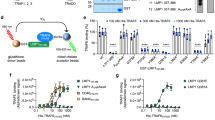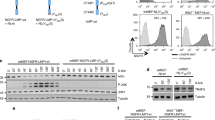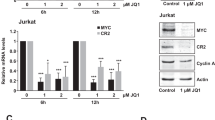Abstract
Epstein–Barr virus (EBV) is a ubiquitous herpesvirus associated with a variety of malignancies including nasopharyngeal carcinoma. The EBV-encoded latent membrane protein 1 (LMP1) is considered the EBV oncogene as it is necessary for EBV-induced B-lymphocyte transformation and has been shown to transform rodent fibroblasts. LMP1 contains two signaling domains, the carboxy-terminal activating region 1 and 2 (CTAR1 and CTAR2), by which NF-κB, phosphatidylinositol 3-kinase (PI3K), mitogen-activated protein kinase, and c-Jun N-terminal kinase are activated. In this study, the role of CTAR1 and CTAR2 in LMP1-mediated transformation of rodent fibroblasts was analysed. CTAR1 was found to be necessary for rodent fibroblast transformation, whereas CTAR2 was dispensable. The activation of the PI3K pathway in Rat-1 cells by LMP1 and LMP1-CTAR1 in transformed cells resulted in phosphorylated Akt and phosphorylated glycogen synthase kinase 3β. The role of PI3K and NF-κB activation in LMP1-mediated transformation was further analysed using the chemical inhibitors LY294002 and BAY 11-7085. LY294002 inhibited CTAR1-induced focus formation and anchorage-independent growth, whereas BAY 11-7085 did not inhibit focus formation or anchorage-independent growth. Similar studies in human fibroblasts confirmed that LMP1-CTAR1 also mediates aberrant growth, phosphorylation of Akt, and decreased levels of p27. These findings indicate that LMP1-mediated rodent fibroblast transformation is dependent upon activation of PI3K and Akt and is independent of activation of NF-κB.
This is a preview of subscription content, access via your institution
Access options
Subscribe to this journal
Receive 50 print issues and online access
$259.00 per year
only $5.18 per issue
Buy this article
- Purchase on Springer Link
- Instant access to full article PDF
Prices may be subject to local taxes which are calculated during checkout






Similar content being viewed by others
References
Atkinson PG, Coope HJ, Rowe M and Ley SC . (2003). J. Biol. Chem., 278, 51134–51142.
Baichwal VR and Sugden B . (1988). Oncogene, 2, 461–467.
Cross DA, Alessi DR, Cohen P, Andjelkovich M and Hemmings BA . (1995). Nature, 378, 785–789.
Dawson CW, Tramountanis G, Eliopoulos AG and Young LS . (2003). J. Biol. Chem., 278, 3694–3704.
Devergne O, Cahir McFarland ED, Mosialos G, Izumi KM, Ware CF and Kieff E . (1998). J. Virol., 72, 7900–7908.
Devergne O, Hatzivassiliou E, Izumi KM, Kaye KM, Kleijnen MF, Kieff E and Mosialos G . (1996). Mol. Cell. Biol., 16, 7098–7108.
Ding VW, Chen RH and McCormick F . (2000). J. Biol. Chem., 275, 32475–32481.
Eliopoulos AG and Young LS . (1998). Oncogene, 16, 1731–1742.
Everly Jr DN, Kusano S and Raab-Traub N . (2004a). J. Virol., 78, 11648–11655.
Everly Jr DN, Mainou BA and Raab-Traub N . (2004b). J. Virol., 78, 13470–13478.
Fahraeus R, Fu HL, Ernberg I, Finke J, Rowe M, Klein G, Falk K, Nilsson E, Yadav M, Busson P, Tursz T and Kallin B . (1988). Int. J. Cancer, 42, 329–338.
He Z, Xin B, Yang X, Chan C and Cao L . (2000). Cancer Res., 60, 1845–1848.
Higuchi M, Izumi KM and Kieff E . (2001). Proc. Natl. Acad. Sci. USA, 98, 4675–4680.
Izumi KM and Kieff ED . (1997). Proc. Natl. Acad. Sci. USA, 94, 12592–12597.
Izumi KM, Cahir McFarland ED, Ting AT, Riley EA, Seed B and Kieff ED . (1999). Mol. Cell. Biol., 19, 5759–5767.
Izumi KM, Kaye KM and Kieff ED . (1997). Proc. Natl. Acad. Sci. USA, 94, 1447–1452.
Kaye KM, Devergne O, Harada JN, Izumi KM, Yalamanchili R, Kieff E and Mosialos G . (1996). Proc. Natl. Acad. Sci. USA, 93, 11085–11090.
Kaye KM, Izumi KM and Kieff E . (1993). Proc. Natl. Acad. Sci. USA, 90, 9150–9154.
Kaye KM, Izumi KM, Mosialos G and Kieff E . (1995). J. Virol., 69, 675–683.
Kieff E and Rickinson AB . (2001). Field's Virology, Vol. 2. Fields BN, Howley PM, Griffin DE, Lamb RA, Martin MA, Roizman B, Straus SE and Knipe DM (eds). Lippincott Williams & Wilkins Publishers: Philadelphia, PA, pp. 2511–2573.
Liebowitz D and Kieff E . (1989). J. Virol., 63, 4051–4054.
Luftig M, Yasui T, Soni V, Kang MS, Jacobson N, Cahir-McFarland E, Seed B and Kieff E . (2004). Proc. Natl. Acad. Sci. USA, 101, 141–146.
Mehl AM, Floettmann JE, Jones M, Brennan P and Rowe M . (2001). J. Biol. Chem., 276, 984–992.
Meng F, Liu L, Chin PC and D'Mello SR . (2002). J. Biol. Chem., 277, 29674–29680.
Miller WE, Cheshire JL, Baldwin Jr AS and Raab-Traub N . (1998a). Oncogene, 16, 1869–1877.
Miller WE, Cheshire JL and Raab-Traub N . (1998b). Mol. Cell. Biol., 18, 2835–2844.
Miller WE, Earp HS and Raab-Traub N . (1995). J. Virol., 69, 4390–4398.
Miller WE, Mosialos G, Kieff E and Raab-Traub N . (1997). J. Virol., 71, 586–594.
Morrison JA, Gulley ML, Pathmanathan R and Raab-Traub N . (2004). Cancer Res., 64, 5251–5260.
Morrison JA, Klingelhutz AJ and Raab-Traub N . (2003). J. Virol., 77, 12276–12284.
Mosialos G, Birkenbach M, Yalamanchili R, VanArsdale T, Ware C and Kieff E . (1995). Cell, 80, 389–399.
Paine E, Scheinman RI, Baldwin Jr AS and Raab-Traub N . (1995). J. Virol., 69, 4572–4576.
Pierce JW, Schoenleber R, Jesmok G, Best J, Moore SA, Collins T and Gerritsen ME . (1997). J. Biol. Chem., 272, 21096–21103.
Puls A, Eliopoulos AG, Nobes CD, Bridges T, Young LS and Hall A . (1999). J. Cell Sci., 112 (Part 17), 2983–2992.
Raab-Traub N . (2002). Semin. Cancer Biol., 12, 431–441.
Reynolds VL, DiPietro M, Lebovitz RM and Lieberman MW . (1987). Cancer Res., 47, 6384–6387.
Roberts ML and Cooper NR . (1998). Virology, 240, 93–99.
Rowe M, Peng-Pilon M, Huen DS, Hardy R, Croom-Carter D, Lundgren E and Rickinson AB . (1994). J. Virol., 68, 5602–5612.
Saito N, Courtois G, Chiba A, Yamamoto N, Nitta T, Hironaka N, Rowe M and Yamaoka S . (2003). J. Biol. Chem., 278, 46565–46575.
Scholle F, Bendt KM and Raab-Traub N . (2000). J. Virol., 74, 10681–10689.
Shtutman M, Zhurinsky J, Simcha I, Albanese C, D'Amico M, Pestell R and Ben-Ze'ev A . (1999). Proc. Natl. Acad. Sci. USA, 96, 5522–5527.
Thornburg NJ, Pathmanathan R and Raab-Traub N . (2003). Cancer Res., 63, 8293–8301.
Wang D, Liebowitz D and Kieff E . (1985). Cell, 43, 831–840.
Young L, Alfieri C, Hennessy K, Evans H, O'Hara C, Anderson KC, Ritz J, Shapiro RS, Rickinson A, Kieff E and Cohen JI . (1989). N. Engl. J. Med., 321, 1080–1085.
Acknowledgements
We would like to thank Dr Eng-Shang Huang's lab for the HEL cells. This work was supported by NIH Grants CA 32979 and CA 19014 to NRT.
Author information
Authors and Affiliations
Corresponding author
Rights and permissions
About this article
Cite this article
Mainou, B., Everly, D. & Raab-Traub, N. Epstein–Barr virus latent membrane protein 1 CTAR1 mediates rodent and human fibroblast transformation through activation of PI3K. Oncogene 24, 6917–6924 (2005). https://doi.org/10.1038/sj.onc.1208846
Received:
Revised:
Accepted:
Published:
Issue Date:
DOI: https://doi.org/10.1038/sj.onc.1208846
Keywords
This article is cited by
-
Nasopharyngeal carcinoma: current views on the tumor microenvironment's impact on drug resistance and clinical outcomes
Molecular Cancer (2024)
-
Quassinoid analogs with enhanced efficacy for treatment of hematologic malignancies target the PI3Kγ isoform
Communications Biology (2020)
-
In silico evidence of de novo interactions between ribosomal and Epstein - Barr virus proteins
BMC Molecular and Cell Biology (2019)
-
Epstein-Barr Virus Latent Membrane Protein-1 Induces the Expression of SUMO-1 and SUMO-2/3 in LMP1-positive Lymphomas and Cells
Scientific Reports (2019)
-
EB-virus latent membrane protein 1 potentiates the stemness of nasopharyngeal carcinoma via preferential activation of PI3K/AKT pathway by a positive feedback loop
Oncogene (2016)



